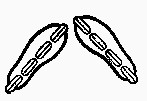Certified inline skating instructors use standard terminology for the body
and skate positions that make it easy for people to understand and learn
new skills. First, the instructor demonstrates and then coaches you into
the stance. During the lesson, there may be subtle corrections to help
you achieve the optimal positions for the dynamic movements of skating.
But what if you live far from the closest instructor and you are learning
skating by surfing the web?
In that case, here are some stances to build your learning
foundation. Practice them first on a non-rolling surface (carpet or lawn).
Once you get out on the pavement, spend plenty of time memorizing the
Ready Position by coasting long distances in it. Then focus on
Scissors Coasting to prepare for the eventual need to learn heel
braking.
 Safe-T: The stance used for standing still. The brakeless
heel is rolled up against the other skate’s inner arch.
Safe-T: The stance used for standing still. The brakeless
heel is rolled up against the other skate’s inner arch.
For safety reasons, this is the first stance I teach! Beginning students
standing on skates for the first time are grateful for the way this
position locks the wheels in place to prevent unwanted rolling.
Ready Position:
The balanced alignment of the body that results in equilibrium and confidence.
 Feet
are shoulder width apart. Shoulders, hip joints and arches are balanced
along an invisible line that runs from head to heel. The joints of
the knees, hips and ankles are bent, with the shins tilted forward
over the toes. During the first skating strokes and while learning
braking, hands and arms are raised to waist level and positioned within
the peripheral vision.
Feet
are shoulder width apart. Shoulders, hip joints and arches are balanced
along an invisible line that runs from head to heel. The joints of
the knees, hips and ankles are bent, with the shins tilted forward
over the toes. During the first skating strokes and while learning
braking, hands and arms are raised to waist level and positioned within
the peripheral vision.
In a proper ready position, the skater is able to hop in place (try this
first on carpet or lawn!) and remain in balance. Find your balanced
Ready Position standing in place at first, then learn to coast long
distances in it without straightening the knees or tipping the upper body
forward. Try lowering and raising the hips repeatedly to loosen up while
coasting this way.
As stroke technique improves, the Ready Position becomes more aerodynamic
(and horizontal). A speedskater’s tuck incorporates a balanced alignment
over one skate at a time.
 Scissors Stance: Skates are parallel and no more than
hip width apart, with one skate ahead of the other, weight mostly over the
back skate.
Scissors Stance: Skates are parallel and no more than
hip width apart, with one skate ahead of the other, weight mostly over the
back skate.
Because the skates are positioned narrower than your body width,
the Scissors Stance presents a balance challenge to most beginners.
Once skaters learn to comfortably roll in this stance, they are ready
to master effective braking and start learning intermediate skills.
See Scissors
Coast to learn why this is such a key stance for skaters
at all levels.
 A-Frame
Stance: A balanced, upright stance with skates positioned parallel
and wider than shoulder width.
A-Frame
Stance: A balanced, upright stance with skates positioned parallel
and wider than shoulder width.
This is the most
stable stance for beginning skaters because of the broad base of contact
at the feet, . The A-Frame was given its name because the whole body
is shaped like the capital letter A. The width of the stance automatically
tips both skates onto their inside edges. Pressure on a tipped skate
causes it to turn, so instructors use the A-Frame stance to teach new
skaters the fundamentals of pressure and upper body rotation. See Basic
Turning (A-Frames).
V-Stance: A version of the Ready Position where the heels
are nearly touching and the toes are pointed out.
 In
this stance, your skates on the pavement form the shape of the letter
V. The V-Stance is the perfect starting point for learning
Swizzles, a building skill that teaches you the beginnings of a powerful
and efficient stride. See more abut that in Technique Tip #4 in Increase
Your Pushing Power.
In
this stance, your skates on the pavement form the shape of the letter
V. The V-Stance is the perfect starting point for learning
Swizzles, a building skill that teaches you the beginnings of a powerful
and efficient stride. See more abut that in Technique Tip #4 in Increase
Your Pushing Power.
A-Stance: A version of the Ready Position where the toes
are nearly touching and the heels are angled out.
 In
this stance, your skates on the pavement form the shape of the letter
A. The A-Stance is the perfect starting point for learning backward
motion. When you push sideways from this stance, pressure along the
inside (tipped inward) wheel edges results in a backward glide. That
is, as long as your upper body does not fall ahead. See Mastering
Swizzles with
the Football Drill for instructions involving the A-stance.
In
this stance, your skates on the pavement form the shape of the letter
A. The A-Stance is the perfect starting point for learning backward
motion. When you push sideways from this stance, pressure along the
inside (tipped inward) wheel edges results in a backward glide. That
is, as long as your upper body does not fall ahead. See Mastering
Swizzles with
the Football Drill for instructions involving the A-stance.